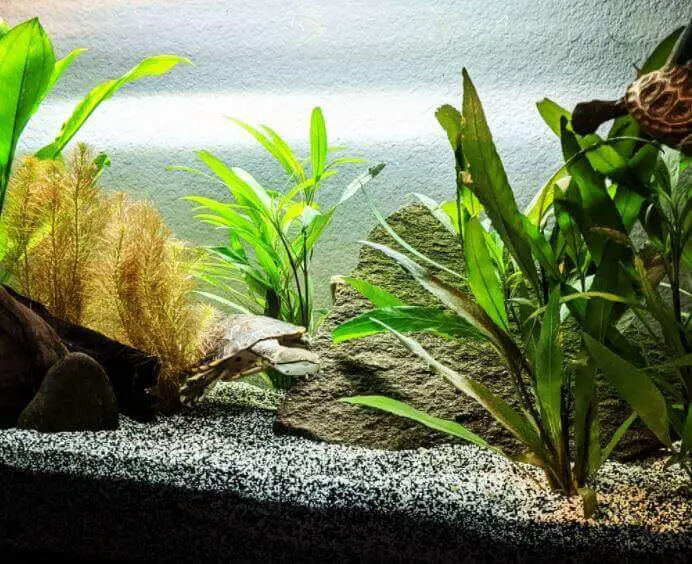Selecting the best turtle substrate is an important decision for your shell reptile pet and also for you as a pet owner.
In this article, we are going to talk about the suggestions and give you a clear idea about choosing the best substrate for your turtle tank.
Our top 5 options will be shown to you as well.
The Top-Rated Turtle Substrate (Recommendations)
#1. ZOO MED REPTISAND – TOP PICK
#2. ZOO MED ECO EARTH COMPRESSED COCONUT FIBER SUBSTRATE – BEST FOR BOX TURTLES
#3. EXO TERRA TURTLE PEBBLES – BEST PEBBLES
#4. CARIB SEA CRUSHED CORAL FOR AQUARIUM – ARAGONITE CRUSHED CORAL
#5. SEACHEM FLUORITE PREMIUM NATURAL SUBSTRATE– BEST FOR PLANTED TANKS
Related:
- Best Substrate For Bearded Dragons
- Best Bioactive Substrate For Leopard Gecko
- What Kind Of Substrate For Bearded Dragons?
Guide for Turtle Substrate
A substratum is usually any substrate you place on the bottom of your turtle tub or tank. It ranges from sand to gravel to charcoal to fluorite, gravel is the most preferable one.
However, a substrate is not necessarily required for common aquatic turtles like red-eared sliders and painted tortoises unless you prefer live plants.
Furthermore, glass aquarium aid will reduce the chance that your shell reptiles eat a substrate or may get hurt.
Cleaning and maintaining are also very convenient.
The kind of sand you choose will depend on your tortoise species.
Aquatic turtles spend much of their time in the sea, so long as you have basking areas, you do not need a substratum.
On the other hand, land turtles require a substrate layer that clothes the bottom of the tank to dig into if they want to.
Some Types Of Substrates For Turtle Aquarium
There are few choices for substrates specifically made for turtles. So it is a good step towards becoming a better owner to learn about the available ones, and why some of them are used and preferred by some pet experts.
1. Gravel:
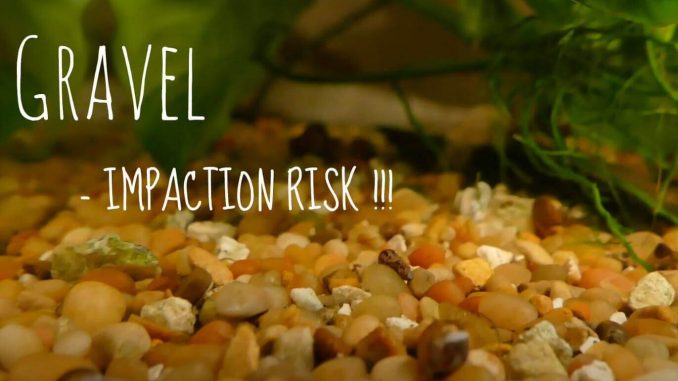
This is the first choice of experts.
First of all, it looks pretty good and makes it look more natural and visually appealing in the tank.
Another thing is that it is capable of holding bacteria, provides a surface area where bacteria can grow, and helps you with water filtration.
The bad thing is that your pet might try to eat it if the gravel is large enough to fit in their mouth.
The problem comes about when the gravel can not be passed by, it becomes an impaction and blocks the pet’s stomach.
We only recommend using gravel that is bigger than the pet’s mouth and can not fit into it.
2. Pebbles or large rocks:
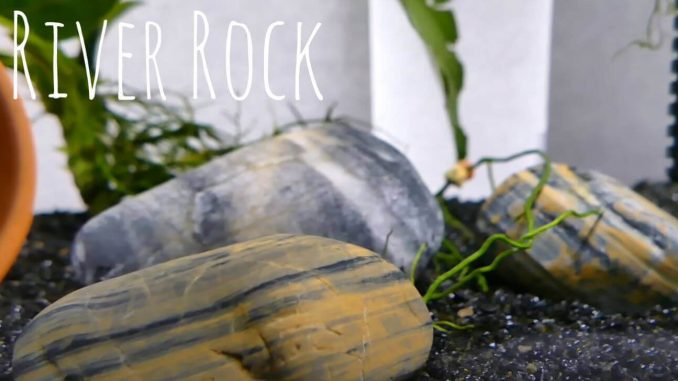
Cre: livescience
Instead of small stones, we suggest using large stones.
Large pebbles will not catch as much waste as smaller ones, helping to keep the water clean.
When they are large, turtles are less likely to swallow them which can avoid the chance of getting deadly injuries.
3. Sand:
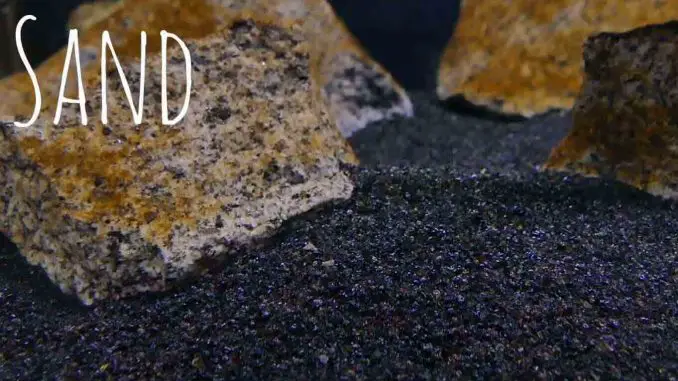
Cre: wikihow
However, personally, our favorite item is the sand one.
The first advantage is that much of it is available inexpensively and readily.
It also looks good and very natural, lets you clean the turtle tank, and does not produce waste such as other substrates.
The tortoises are able to absorb sand because they can pass it easily.
It is advisable for you to place sand in your closure for some tortoises, especially considered as the best substrate for softshell turtles, because they prefer to burrow into it and stick their heads upwards.
There are also some other types of the substrate such as naturalized crushed coral, crushed walnut shells, or products that contained calcium as well as other minerals, etc.
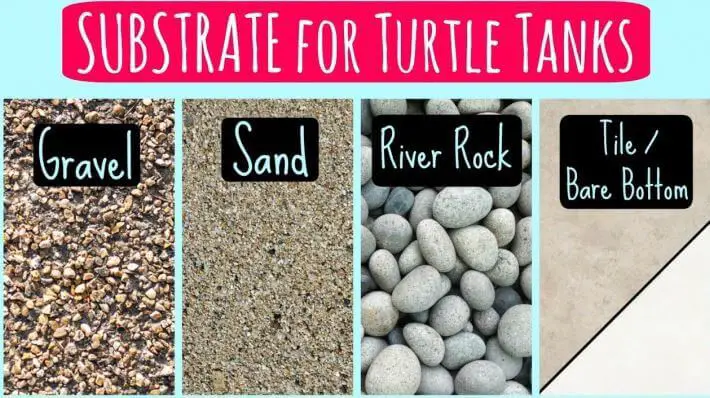
(Credit: The Turtle Girl)
By the way, if you are looking for the best substrate for an African side neck turtle, or alligator snapping turtle, you should leave the tank’s bottom blank.
If you want to enrich or decorate for aesthetic purposes, large gravels that do not fit the animal’s mouth can be used.
Especially, the best substrate for a box turtle is an orchid bark combined with a humid bedding and a moist factor-like peat moss. Box turtles need a sand and soil mixture but should not be totally dry.
Best Turtle Substrate Shortlist (Updated List)
| Product images | Product names | Editor's rating | Price |
|---|---|---|---|
 | Zoo Med ReptiSand | 4.8 | Check Price |
 | Zoo Med Eco Earth Compressed Coconut Fiber Substrate | 4.8 | Check Price |
 | Exo Terra Turtle Pebbles | 4.5 | Check Price |
 | Carib Sea ACS00110 Crushed Coral for Aquarium | 4.7 | Check Price |
 | Flourite | 4.3 | Check Price |
*Ratings are from Amazon at the time of publication and can change
Best Turtle Substrate – What Is The Most Suitable One?
#1. ZOO MED REPTISAND – TOP PICK
Key features:
- No colors or dyes added, 100% natural
- Type: Sand
- Ideal for desert reptiles
- Stimulates natural digging and burrowing behavior
- Crafted to be easy to set up and use
- Claw-feet for your bearded dragon, sand boa, or softshell turtle
After checking a lot of turtle substrates, we came to a clear understanding of the features that make the best substrate for turtle aquarium, and our undeniable pick is the Zoo Med ReptiSand product.
The look, the feel, and the consistency make us think this is our best selection.
This sand is perfect for some kind of softshell turtle as the sand is really soft and it looks right at home, giving your pet something else to do all day long.
A turtle obviously loves no other than burrowing into the sand because this is an outstanding heat conductor.
Combined with the natural decorations of the tank, this sand provides a rather naturalist and enticing turtle setting.
Pros:
- Looks great
- Easy to spot clean
- Not dusty
- Enhances the natural instincts of your reptile pets
Cons:
- Not healthy to eat
- Sand may get into the turtle’s eyes and mouth
- Might be too grainy
#2. ZOO MED ECO EARTH COMPRESSED COCONUT FIBER SUBSTRATE – BEST FOR BOX TURTLES
Key features:
- Available in 3 packages containing 3 bricks each
- Ideal for naturalistic terrarium types for reptiles, amphibians, or invertebrates
- Use it damply for tropical organisms as natural odors and waste products are consumed and broken down
- 100% made from natural coconut husks
- Can be safely composted or recycled into potted plants or gardens
- Great for humidity
Zoo Med Eco Earth Compressed Coconut Fiber product is typically sold as bricks or already loosened.
The brick can be taken easily placed in a bucket, applied a little warm water, and expanded very fast in loose, moist bedding.
It is all organic, non-toxic, and really cheap compared to its quality. It is the best turtle substrate for box pets.
Since being made from coconut fibers, this product can hold your reptile’s enclosure moisture high.
In order to protect their bodies safe, most tortoise species need a certain amount of moisture.
Lack of sufficient humidity can cause health issues and even deadly complications.
However, we would not consider using only coconut fiber for any ecosystem as your turtle box bedding.
It is pretty loose, if you need anything denser, get some soil or clay.
For your box tortoises, it would be very difficult to burrow because it does not keep its form very well on its own.
So your turtle can just finish moving to one side of the box.
Pros:
- Made from 100% natural coconut fiber
- Makes tanks look good
- Maintains sufficient tank moisture
Cons:
- Not easy to clean up
- Not recommended for aquatic turtles
- Need to be processed before use
#3. EXO TERRA TURTLE PEBBLES – BEST PEBBLES
Key features:
- Smooth pebbles help bottom dwelling or foraging turtle avoid harm
- The color and pattern variations create a natural riverbed
- Size: 0.3 to 0.4 inches sized round pebbles, suitable for turtles with a shell diameter of 4 inches or lower
- Packed in a 10-pound bag.
You can trust the Exo Terra Turtle Pebbles without a doubt if you do not know which sort of substratum to choose for your pet tortoise tank.
The pebbles are round-edged and smooth so that they do not harm the tortoise and serve as a simple coating on the bottom of a terrestrial turtle tank.
The right size of this product also ensures that the pet will not accidentally chew on them, which would cause the impact.
Packed in different colors and patterns, they help to make your tank look natural.
Moreover, they are really easy to clean. The pebbles can be reused by only washing them in a bucket of water and disinfecting them for about 15 minutes.
Make sure that you properly rinse after soaking until the water is clear.
Pros:
- Smooth edges minimize risks of injury
- Easy to clean
- Brings a natural appearance thanks to variable colors and patterns
- Safe to use
- Reusable
Cons:
- Turtles can not dig or burrow into it
- Must be rinsed to remove dust before use
#4. CARIB SEA CRUSHED CORAL FOR AQUARIUM– ARAGONITE CRUSHED CORAL
Key features:
- Made from crushed coral that contains aragonite
- Provides over 25 times the buffering capacity compared to other products
- Can use alone or as a textual admixture
- Great to help to deal with pH issues
In contrast to sand, the Carib Sea Crushed Coral offers a more natural and esthetically pleasing substrate for turtle owners.
This substratum is one of the most popular coral beds on the market.
It contains aragonite from the ocean and is high in minerals and calcium. It has a naturalized and screened size.
This aragonite content naturally increases the pH level of water. The longer you use, the greater up to a certain point the acidity of the water.
It does not blow around the weight of this product.
In addition, for an eye-catching appearance, you can mix this substrate with smooth and fine pebbles.
The Carib Crush Coral is the best safest turtle substrate to use if you have a saltwater or brackish-water turtle.
Pros:
- Aragonite contained
- Gives a realistic appearance to the tank
- Ideal for diamondback terrapins because they want to crush their strong beak shells
- Naturalized product
Cons:
- Be careful when using as the increase of acidity in your water
#5. SEACHEM FLUORITE PREMIUM NATURAL SUBSTRATE – BEST FOR PLANTED TANKS
Key features:
- Rinse in the bag
- Made from natural Porous clay
- Ideal for planted aquarium
There is nothing more natural to your turtle aquarium than adding live plants into it.
Live plants can also help to keep the tank clean and provide your pet turtle with additional food sources.
The Seachem Fluorite Premium Substrate is therefore one of the best aquatic turtle substrates.
It is a naturally porous clay that encourages plant growth in the water environment.
This substrate consists of porous gravel, especially fractured and durable ideal to plant water, great for use in any freshwater aquarium.
You can choose to mix it with other gravels, however, when fluorite is at its best when being used alone.
Fluorite is a natural mineral which does not require laterite modifications for its application.
Moreover, it is not chemically shielded or processed such that the water’s pH will not change. This substance is viable and no need for replacement for an entire lifetime.
Pros:
- Encourages safe aquatic plant life growth
- Made from all-natural porous clay
- Easy to clean and use
- Makes your turtle tank looks great
Cons:
- It has to be thoroughly rinsed before use because it is kind of dusty
What To Look For When Buying The Best Turtle Substrate
It is a difficult job to pick a suitable bed for a pet tank. Here are several main factors that help you to pick the best substrate for your turtle pond:
1. Material:
The material is the first thing you have to look for.
This would give a totally big difference to your pet’s overall experience.
A lot of kinds of sands with many different materials are available nowadays.
Choose it carefully to fit your setup and give a happy life for the animals.
2. Sand:
It is made of both quartz and calcium carbonate pure sand.
Both compounds exist naturally and supply your tank with pleasant bedding.
This form of sand can help with the digestion of the pet and it can burrow into when it feels hot.
However, cleaning is not so easy.
While all the waste is absorbed, it does not form clumps, making it very hard to clean.
3. Chemicals:
For your pet reptiles, wellbeing is an immense concern.
Many of the substrates are treated with toxic compounds that can pose a significant danger to the health of your pets if swallowed.
They may be absorbed through their skin even though they do not eat.
Make sure you do not poison your pet just to save some money.
Choose high-quality products instead.
4. Impaction:
This arises when the reptile eats something too big to swallow.
This generally occurs if the grains are much bigger than what they can consume.
Impacts in the digestive tract can develop food and lead to additional strain on the vertebra, which can lead to paralysis in the worst situations.
Therefore, we advise that you check the grain size that can easily pass through your pet’s systems.
5. Grain size:
The size of the grain, in this case, is highly significant.
The more fine the sand is, the better your pet would be.
Fine-grained sand decreases the risk of impacts and even small grains can support digesting processes.
Baby reptiles tend to have more impacting complications, so a smaller grain of sand is advised for them as much as possible.
6. Washing:
Some sands can create clumps in order to extract the waste quickly.
While the majority of sands do not clump well, some variants have this trait.
We recommend you to review the specifications before ordering to see whether the clumps can be made or not.
There are also natural purification processes for some sands.
This helps maintain a safe and balanced ecosystem in the tank and keeps bacteria and disease from overgrowing.
7. Budget:
In the end, everything falls under the budget.
Extremely pricey products perform well but it is not necessary to buy a too high-priced product.
As you already know, sand is not a one-time buy and you may have to change it over and over.
However, you do not have to go for the cheapest to get bad quality in return. Purchase the most cost-effective sand.
You should use cheap substrates more frequently than pricey ones since they do not create clumps that waste more of the sand.
They say that every month you have to absolutely change the sand to keep your pet safe and healthy. Normally, how much sand is used depends on the size of the tank, 10 pounds are more than adequate to get in.
8. Package size:
You can buy as big as possible size and in bulk. Not only is this convenient, but it also saves you a lot of money because larger bundles give a decent value for money.
Check the following illustration on how to set up a good tank for the earned slider:
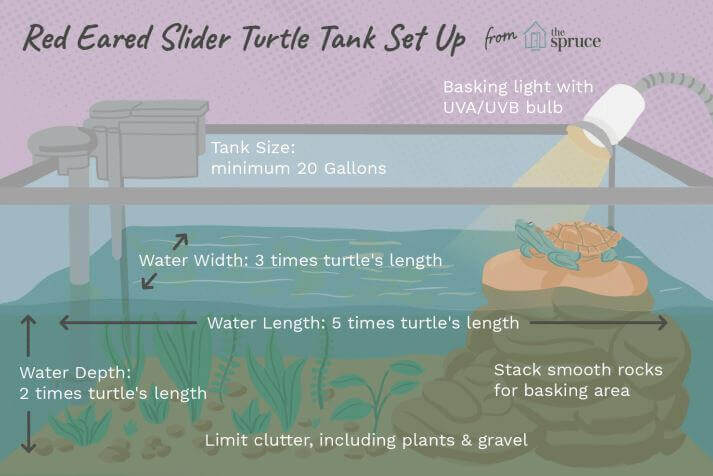
(Credit: The Spruce Pets)
Frequently Asked Questions about Turtle Substrate
1. Do Turtles Eat Substrate?
This hypothesis is not proven in any actual scientific studies, so our proof is empirical. From what we saw, the turtles would attempt to consume anything fit into their mouths, so our list consists of substrates that, while they are feeding, are healthy for the tortoises.
2. How Frequently Should I Replace The Bottom?
It depends on the type of sand you use. You can wash and reuse gravel again. If you use sand, it is better to replace it every few months. You do not have to replace it if it is a planting substratum.
3. Which Are The Aspects Of The Water I Should Check?
Certain types of turtle substrates can influence water quality more or less greatly. Poor water conditions can lead to some health issues, and if not detected it can cause death. The water quality is central to 4 aspects:
- pH
- Ammonia
- Nitrites
- Nitrates
4. Do I Really Need Substrate?
A substratum that lines the base of the tank. You do not absolutely need a substrate bed unless you want to use live plants that need to root in or keep digging turtles like the softshell species.
Read more:
- Best Substrate For Russian Tortoise
- Best Substrate For Sulcata Tortoise: Guideline For The New Keepers
- Top 7 Best Substrate For Chameleons – Complete Guide
5. Any Tip For Decorating A Good Turtle Tank?
- Choose the biggest tank you can afford. Your turtle spends most of its time in that tank and it must be large enough to demonstrate normal habitat to the pet.
- Fit your tank to the kind of turtle you have got. You can have a basking area for all tortoises, but river ones require more swimming space than the ground ones.
- Choose a good substrate. We have already mentioned a lot about this above.
- Add natural decorative features, such as flowing stones, plants, and water, to make them look like the natural environment.
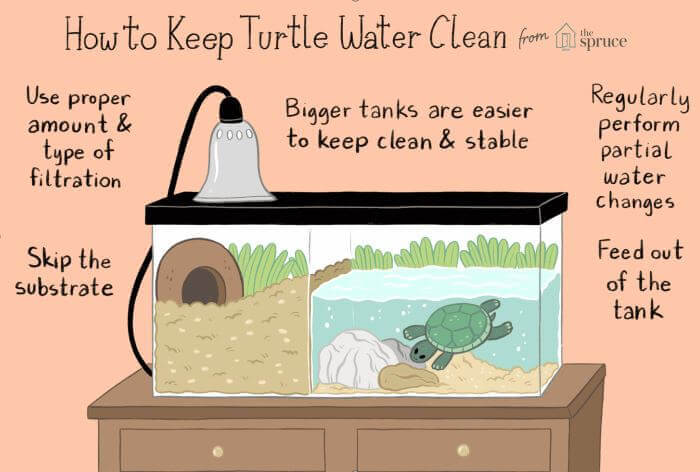
Conclusion
Hope you have selected the right substrate for your tank after reading our article. We want to repeat that substrate made of natural and organic materials is the best option, regardless of which brand.
We highly recommend using ZOO MED REPTISAND. This product is affordable in price and either easy to use either. The manufacturer offers a variety of colors for you to choose from, but as our experience, light colors are the best. For tanks decorated with plants, SEACHEM FLUORITE PREMIUM NATURAL SUBSTRATE is a perfect choice. It supports both the growth of the aquatic plants and the living environment of your reptilian friends.
The choice of the best turtle substrate that best suits your pets need to be taken carefully in relation to safety. Stay on branded products in your tank, as well as the reptilian itself, to prevent complications. Depending on your tortoise species, you can choose to mix different types or use just one kind alone. Each species is different, and you must make careful research until you find something suited to its comfortabilities.
Key points for selecting the best turtle substrate:
Choosing the right substrate for your turtle’s enclosure is crucial for their well-being. It not only provides a naturalistic environment but also plays a role in maintaining hygiene and facilitating behaviors like digging and basking. Here are key considerations when selecting the best substrate for your turtle:
1. Species-Specific Needs:
- Different turtle species have varied habitat preferences. Research your turtle’s specific requirements to ensure the substrate is suitable.
2. Safety and Ingestion Risk:
- Opt for substrates that are non-toxic and free from chemicals or contaminants.
- To prevent ingestion, avoid substrates that are too small and could be swallowed.
3. Ease of Cleaning:
- Substrate should be easy to clean and replace, as turtles can be messy.
- Consider materials that don’t trap waste and allow for efficient cleaning.
4. Hygiene and Odor Control:
- Choose substrates that help control odors and maintain a clean habitat.
- Some materials, like coconut coir or cypress mulch, excel in odor reduction.
5. Natural Appearance:
- Naturalistic substrates like cypress mulch, coconut coir, or organic topsoil provide an aesthetically pleasing environment.
6. Moisture Retention:
- Some turtles, like aquatic species, require substrates that retain moisture.
- Materials like coconut coir hold moisture well and create a suitable environment.
7. Heat and Humidity Regulation:
- Consider the thermal properties of the substrate.
- Materials like ceramic tiles or slate can help maintain stable temperatures.
8. Burrowing and Nesting:
- If your turtle species enjoys burrowing or nesting, select substrates that facilitate these behaviors.
- Organic topsoil or a mix of topsoil and sand can be suitable.
9. Ease of Maintenance:
- Materials that can be spot-cleaned and refreshed as needed are preferable.
- Avoid substrates that require frequent complete changes.
10. Texture and Comfort: – Some substrates may provide a more comfortable surface for your turtle to walk on or bask. – Consider your turtle’s preferences for texture and softness.
11. Budget and Availability: – Evaluate the cost and accessibility of the substrate. – Some materials are more budget-friendly and widely available.
12. Reptile-Specific Substrates: – Commercial reptile substrates designed for turtles are available. – These substrates often meet safety and cleanliness standards.
13. Combined Substrate Types: – A mix of substrates can sometimes provide the best of both worlds. – Combining materials like cypress mulch and coconut coir can offer ideal conditions.
14. Consult with Reptile Experts: – Seek advice from experienced turtle keepers or herpetologists for substrate recommendations specific to your turtle species.
In summary, selecting the best substrate for your turtle’s habitat involves considering species-specific needs, safety, ease of cleaning, and moisture retention. A natural appearance, thermal properties, and suitability for burrowing or nesting should also be factored in. Prioritizing ease of maintenance and substrate texture ensures your turtle’s habitat remains clean and comfortable. Budget and availability play a role, but the health and happiness of your pet should always be the foremost concern.
Further Reading:

